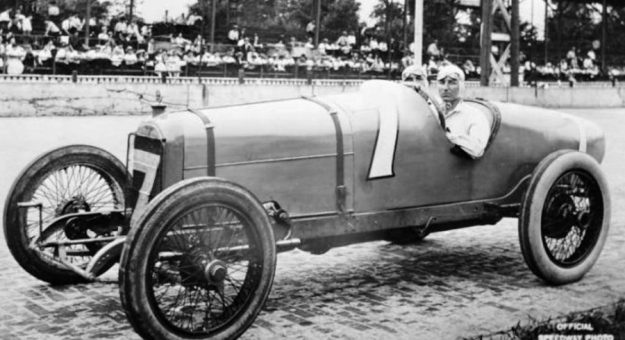Joe Boyer, co-winner of the 1924 Indianapolis 500, was born into wealth.
A distant relative, William Seward Burroughs, invented and manufactured the Burroughs Adding Machine. And when Boyer was born on May 30, 1890, his father was the CEO of the profitable company.
Proficient in sailing and an accomplished equestrian, in 1915 he became enamored with auto racing. His early involvement was financially supporting the struggling Chevrolet brothers’ racing efforts.
For two years as close as Boyer got to driving a race car was practicing the Chevrolets’ Frontenacs at Indianapolis. In 1917, his continued financial help earned him sporadic rides with the Chevrolets, and he displayed his talent by taking the pole for the season’s first AAA Championship race.
By 1919, he deemed himself ready for a shot at the Indy 500. To ensure he got the best of the Chevrolet equipment, he offered Louis Chevrolet a staggering $27,000 ($450,000 in today’s money) for the ride.
He proved himself with impressive runs on the rest of Championship Trail, scoring his first win on Cincinnati’s two-mile board track.
Referred to in the press as “Millionaire Daredevil Joe Boyer,” he became one of the stars of the thrilling, dangerous, blindingly fast board track era. An excellent qualifier, he was usually at the front when time trials concluded. He qualified on the front row at Indianapolis twice, and his qualifying speeds there never ranked lower than seventh.
It was his ability to wring the most out of a car that pulled him from the Chevrolet brothers to the Duesenberg brothers in 1924. The Duesenbergs were on the verge of not surviving. Their competition, the Chevrolets and the comparative newcomer Miller, were dominating the races. They needed a significant turnaround to continue racing.
Over the winter of 1923, the Duesenbergs secretly worked on a centrifugal supercharger. It was the first on an American car and they believed Boyer was the man to get the most from it.
Said Fred Duesenberg, “Joe Boyer is a wild man. His job on our team is to press the accelerator to the floor and endeavor to trap other drivers into a race with him, a race run at such a pace that either car or man must give out by the finish and only Joe can survive.”
They built three supercharged cars for the 1924 Indianapolis 500. Boyer was the fastest of the trio, qualifying his wine-colored racer fourth. On the first lap, he screamed by the entire front row — Jimmy Murphy, Harry Hartz and Tommy Milton.
But his run was short-lived. Within two laps a key sheared off in the supercharger gears.
His teammate, Ernie Ansterburg, had crashed after a steering pin broke, leaving only the Duesenberg of L.L. Corum in the race. Corum, a journeyman driver, languished in fourth place.
Desperate for a victory, Fred Duesenberg grabbed Boyer and told him, “Maybe we can still win. Get your goggles, when Corum pits for fuel and tires, I want you in the car.”
They made the switch on lap 112. Duesenberg shouted his final instructions to Boyer, “Put that ship out front or burn it up.”
Boyer proceeded to go to the front. The supercharger screaming like a wailing banshee, he charged through the field. On lap 177, he blew past Earl Copper’s Miller into the lead and took the checkered flag as the winner of the fastest 500 in history.
Boyer became the first co-winner in Indianapolis history and it was the first win for a supercharged car. The $30,000 first-place money was pocket change for Boyer and he graciously gave it to Corum, who had a wife and children.
Boyer’s father telegrammed him afterward saying, “Congratulations. Now let’s try something else.”
He didn’t step away.
At the Altoona, Pa., board track on Sept. 1, Boyer crashed heavily. Newspaper reports proclaimed him heroic because, after his tire blew, he deliberately turned his car toward the heavy timber outer guardrail, away from the spectator-filled infield.
As rescuers wrestled him from the wreckage, he mumbled, “I’m glad I saved them.” Those were his last words. His legs crushed, Joe Boyer died the next day.
